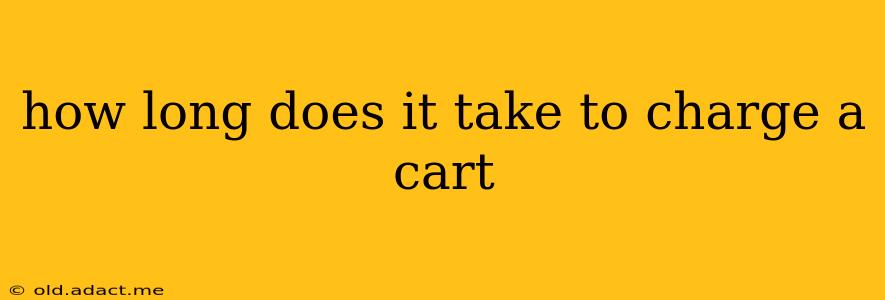How Long Does It Take to Charge a Cart Battery?
Charging a golf cart battery, whether it's lead-acid or lithium-ion, depends on several factors. There's no single answer, but understanding these variables will help you estimate charging time. This guide will break down the process and answer some common questions.
Factors Affecting Charging Time:
-
Battery Type: Lead-acid batteries are the traditional choice for golf carts, and they charge slower than lithium-ion batteries. Lithium-ion batteries, while more expensive upfront, offer significantly faster charging times and longer lifespans.
-
Battery Capacity (Amp-hours or Ah): A higher Ah rating indicates a larger battery capacity, requiring a longer charging time. A 6-volt 200Ah battery will take considerably longer to charge than a 6-volt 100Ah battery.
-
Charger Type: The type of charger significantly impacts charging speed. Slow chargers (typically 10-15 amps) take much longer than fast chargers (30-50 amps or more). Using an incorrect charger can damage the battery.
-
Battery State of Charge (SOC): A completely depleted battery will naturally take longer to charge than one that's only partially discharged.
-
Ambient Temperature: Extreme temperatures, both hot and cold, can slow down the charging process and potentially damage the battery.
-
Charger Condition: A malfunctioning or aging charger will likely increase the charging time and may not fully charge the battery.
How Long Does it Take to Charge a Lead-Acid Golf Cart Battery?
Charging a standard lead-acid golf cart battery typically takes 8-12 hours with a slow charger. Faster chargers can reduce this time to 4-6 hours, but always refer to your charger's and battery's manufacturer recommendations. Never leave a lead-acid battery on a charger indefinitely, as this can lead to overcharging and damage.
How Long Does it Take to Charge a Lithium-Ion Golf Cart Battery?
Lithium-ion golf cart batteries boast significantly faster charging times. Depending on the charger and battery capacity, a full charge can often be achieved in 2-4 hours, sometimes even less. However, always check your specific battery and charger's instructions, as charging times vary. These batteries are also less susceptible to damage from overcharging, thanks to built-in protection systems.
What Happens if I Overcharge My Golf Cart Battery?
Overcharging can severely damage both lead-acid and lithium-ion golf cart batteries. Lead-acid batteries can suffer from electrolyte loss, plate sulfation, and potentially even venting of flammable gases. While lithium-ion batteries have built-in protection systems, chronic overcharging can still shorten their lifespan and degrade their performance.
Can I Leave My Golf Cart Charger Plugged in After It's Fully Charged?
With lead-acid batteries, it’s generally recommended to unplug the charger once charging is complete to avoid overcharging. Lithium-ion batteries often have charging systems that automatically stop charging once the battery is full, minimizing the risk of overcharging. However, leaving it plugged in for extended periods might still put a slight strain on the battery management system over time. Always consult your battery and charger manuals for specific recommendations.
How Can I Extend the Life of My Golf Cart Battery?
Regular maintenance is crucial for maximizing battery lifespan. This includes regularly checking the electrolyte levels (for lead-acid batteries), avoiding deep discharges, storing the cart in a cool, dry place, and using the correct charger. For lithium-ion batteries, following the manufacturer's charging recommendations is key.
By understanding these factors and following best practices, you can ensure your golf cart battery receives optimal charging and enjoys a long, healthy lifespan. Always refer to your battery and charger manuals for specific instructions and recommendations.
